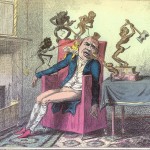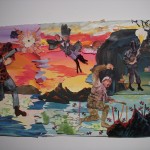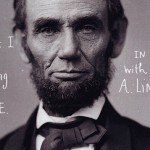Take a look at the sweet, witty video installation linking global warming to Medieval fears of Apocalypse now, installed in the Rosenbach Museum and Library in Philadelphia.
A reception and talk by the artist, the multi-talented Martha Colburn, takes place this afternoon (Wednesday, July 18), 5:30-7:30 p.m.
The video, Don’t Kill the Weatherman!, was inspired by the medieval manuscript, Three Pilgrimages, by Guillaume de Deguileville, one of the works in the Rosenbach’s collection. The three stories in the richly illustrated manuscript are (my translation), the Pilgrimage of Life, the Pilgrimage of the Soul, and the Pilgrimage of Jesus Christ. Both the video (in duplicate, slightly out of sync) and the book, behind glass, as well as the drawings Colburn used in making the video, are installed in the French Room.
Colburn borrowed imagery from the book, with its foreboding sense of disaster, to tell the story of a real, contemporary imminent disaster–the end of life on earth as we know it. Among the highlights are images of chain-saw wielding damsels destroying trees, and devils at the gas pump filling up vehicles.
All the events, which take place in cosmic as well as earth-bound space, are backed by a soundtrack of a French weather forecast set to baroque music, sung by baritone Greg Purnhagen and backed by cellist Martha Colby, with Foley effects by Mike Evans. The video loop repeats approximately every 3 1/2 minutes.
Colburn manages a light touch, even though Weatherman is a dire moral tale. It’s even suitable for children. A couple of folding chairs have been installed in the French Room for video viewers.
Colburn’s video made me think how different it was from some awful “art” I saw in Chicago with a similar message of an endangered planet. But the mistake in Chicago was a dictum that contributing artists must make globes to express the concept. The results were heavy-handed and literal. I’m linking to a couple of photos I put up on Flickr of some of the best of these globes (here and here). Right now I just want to say, no more fiberglass cows, or dogs, or dolphins, or other kitsch substrata for artists to decorate. It’s just depressing and wrong-headed.
I wondered how Colburn’s Rosenbach commission came about. Catherine Parmar, the Associate Director of Education there, said after seeing Colburn’s work in an exhibit at Stux Gallery in New York, she invited Colburn to participate in the series of arts projects that the museum began back in 1998–commissioning work inspired by the collection.
When Colburn arrived at the Rosenbach, she began her research into collection holdings related to feminine icons like Marlena Dietrich. She also explored the original Alice in Wonderland. In the course of her intentional research, she came upon the de Deguileville work and saw a parallel between the afterlife in the book and the threat of ecological catastrophe.
The exhibit will run until Sept. 16.









